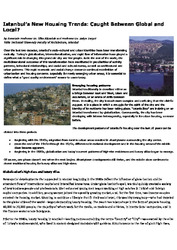Istanbul’s new housing trends: caught between global and local?
| dc.contributor.author | Altinoluk, U. | |
| dc.contributor.author | Turgut, Hülya | |
| dc.date.accessioned | 2016-02-02T13:12:27Z | |
| dc.date.available | 2016-02-02T13:12:27Z | |
| dc.date.issued | 2003 | |
| dc.identifier.issn | 1079-3933 | |
| dc.identifier.uri | http://hdl.handle.net/10679/1360 | |
| dc.identifier.uri | http://info.aia.org/aiarchitect/thisweek03/tw0725/0725istanbul.htm | |
| dc.description.abstract | Over the last two decades, Istanbul’s socio-cultural and urban identities have been transforming radically. Turkey’s globalization, internationalization, and rapid flow of information have played a significant role in changing this grand old city and her people. As in the rest of the world, the multidimensional outcomes of this transformation have manifested in peculiarities of activity patterns, behavioral relationships, and social and cultural norms, as well as architectural and urban patterns. This rapid economic and social change demands continual redefinition of urbanization and housing concerns. Especially for newly emerging urban areas, it is essential to define what a “good quality environment” means to users today. | en_US |
| dc.language.iso | eng | en_US |
| dc.publisher | The American Institute of Architects | en_US |
| dc.relation.ispartof | AIArchitect | en_US |
| dc.rights | openAccess | |
| dc.title | Istanbul’s new housing trends: caught between global and local? | en_US |
| dc.type | Article | en_US |
| dc.description.version | publisher version | |
| dc.peerreviewed | yes | en_US |
| dc.publicationstatus | published | en_US |
| dc.contributor.authorID | (ORCID 0000-0001-8105-7794 & YÖK ID 60288) Turgut, Hülya | |
| dc.subject.keywords | Istanbul | en_US |
| dc.subject.keywords | New housing trends | en_US |
Files in this item
This item appears in the following Collection(s)
Share this page



